Deir el Medina, released driver, took public ferry to east bank [10egp/pp for foreigners], Mummification museum, Luxor sign, back to apt by public ferry
Due to its location, the village may not have provided a pleasant environment. the barren surrounding hillsides reflecting the desert sun and the hill of Gurnet Murai cutting off the north breeze, as well as any view of the verdant river valley.
The wages paid as food were triple that of agricultural workers.
The
working week was eight days followed by two days holiday, though the six days off a month could be
supplemented frequently due to illness, family reasons and, as recorded by the scribe of the tomb, arguing with one's wife or having a hangover.
Including the days given over to festivals, over one-third of the year was time-off for the villagers during the reign of Merneptah (c. 1213–1203 BCE).
During their days off the workmen could work on their own tombs, and since they were amongst the best craftsmen in Ancient Egypt who excavated and decorated royal tombs, their own tombs are considered to be some of the most beautiful on the west bank
Tomb TT1, SENNEDJEM
Sennedjem lived during the 19th Dynasty, under the reign of Pharaoh Sethy I and the first years of Ramesses II.
at least three generations of the same family were united in the same chamber.
There were actually no less than twenty bodies discovered. Nine among them possessed very beautiful anthropoid, simple or double coffins, finely painted and varnished. They belonged to Sennedjem, his wife Iyneferti, his son Khonsu and his wife Tamaket; also of his other children : Parahotep, Taashsen, Ramose, Isis and finally, that of a small girl named Hathor. Eleven others did not have coffins.
Below is the South wall. There are two horizontal registers. In the lower registers are the hosts of the funerary meal who are turned toward the entrance, to receive the deceased couple.
on the left, when facing it, are the guardian demons who should prove whether they are worthy to enter.
on the right , is the continuation of ch 17 of the Book of the Dead.
Above the banquet is a scene of funeral vigil of the mummy, which occupies the whole upper register on this side of the entry. This is a another vignette concluding ch17 of the Book of the Dead, which began in the entrance. It probably also makes reference to a ceremony which would have been held in the courtyard of the chapel before the burial
A light construction, in wood and canvas, protects the mummy of Sennedjem.
A lion-styled bed (head, tail and paws) expresses the arrival at the end of the journey, at the horizon of the western sky. The beautiful anthropoid coffin, the main body of which is enclosed prophylactic bands on which text would have been written, lays with the head towards the west, the domain of the deceased. It is protected by two falcons representing the two goddess sisters, Isis and Nephthys. They wear on top of their heads the hieroglyph of their name.
Isis is at the feet and behind her is the text, a reminder of her functions; she is "the great divine mother, mistress of the sky, wife of all gods".
Nephthys, "powerful in speech, mistress of the sky, mistress of the two lands", who has the power to transfuse the vital fluid, is at the head, and proclaims : "I come to protect the Osiris, the servant in the Place of Truth, Sennedjem".
Why were these birds of prey chosen as icons for the goddesses ? Could it be because their shrill cry is a reminder of eastern laments, a cutting sharp scream, which usually accompany funeral vigils ?
In accordance with the well known Osirian myth, the sisters watch over the deceased, the new Osiris, as they watched over their brother (husband of one, lover of the other) the dead Osiris.
So the assimilation of Sennedjem with the Great God appears complete.

In the pic below
The deceased again appears mummified on a bed, head towards the west. Anubis, by the magic passes of his hands, "warms" the mummy's heart, which starts beating again; at the time of the real ceremony, a priest having dressed in anubis mask plays the role of the god. This scene is usually (and also more logically) represented on the west wall of the chamber.
All around the scene is inscribed the long text of the ch1 of the Book of the Dead, which asks for the exit on the day after the funeral. From lack of space, the scribe could not write the whole chapter, which is interrupted in the middle of a sentence (which shows maybe that he didn't really understand what he recopied…

below
Osiris stands upright (which is quite rare, he is normally seated) in a magnificently decorated kiosk with a white background. The kiosk stands on a pedestal, also white, and has a coving at the entrance.
The roof is sustained by four fascicule columns (of which only two are represented)
Sheathed in his white shroud, Osiris holds in his hands the two usual symbols of his function : the crook and the flagellum. A large necklace decorates his neck. His complexion is greenish, a reminder that flesh is thus in putrefaction, but also of the renewal of vegetation. His chin is decorated with a large false beard with a hooked tip. He wears the Atef crown, either side of which are two udjat eyes, symbolising the resurrected god.
Below, on the left, is introduction
of Sennedjem in front of Osiris, guided by Anubis
in the center, Reproduced in many books on Ancient Egypt, perfectly preserved, is this wall that the tomb owes its reputation
The tympanum
Here we find the solar barque (Wia), greeted by two baboons, which travels from north to south.
The location of this scene appears logical : it is located in the "sky" of the east wall, the baboon of the north greets the setting sun, and the one of the south, its early rising. The chattering which the baboons make at dawn and at twilight, were taken as greetings by the Egyptians.
Perched above this is a swallow, regeneration of soul Ka/Ba, only seen in the tombs of Deir el-Medina
A hawk-headed solar god is seated in the centre of the barque, his head surmounted with an enormous solar disk encircled by a uraeus. He holds in his hand an ankh-sign, the symbol of life. In the text he is named : "Ra-Horakhty-Atum, Lord of the two Lands of Heliopolis, Kheper-Re". Thus the two different phases of the solar life are joined. The star is born in the form of the Kheper scarab, on the eastern horizon; Ra at the zenith, his power decreasing and it as Atum that he will lie down in the western horizon
In front of him is a large shemes sign, represents the followers of Horus, that is , the blissful dead, of which Sennedjem wishes to be part.
Behind the god is a small structure in the shape of Per-nu, the primitive shrine of Buto, in Lower Egypt
in the register just under the barque, Sennedjem and wife Iyneferti kneel in the desert of realm of the dead. They recite a prayer of praise to five gods, squatting on a Ma'at sign.
the Opening of the Mouth ceremony is performed in the right
The main area is the "Fields of the Netherworld" where the deceased has to work... of course he has Ushabtis/ Funerary Servants to do the actual work.
Sennedjem cuts the ears of corn, wife follows Sennedjem and collects the ears which have fallen to the ground in a basket.
next is harvesting flax. This plant is primarily used for the manufacture of linen, but it is also grown for its seeds (linseed) for the production of oil. Sennedjem pulls the stems, Iyneferti follows him and collects the flax into sheave
Finally, ploughing and sowing. Sennedjem pushes at the rear of his plough pulled by two cows (oxen are never used for this work)

Below is the illustration of ch100 of the Book of the Dead : "Book Of Making Perfect a Deceased and allowing him to descend into the Barque of Re with those who are in his retinue".
Ra-Horakhty-Atum stands in his solar barque. It is represented with a stern and a prow in the form of an papyrus umbel. It displays an udjat eye at both the front and the rear. It travels from west to east on the underground Nile.
In front of Ra stands the Benu bird, the Nubian heron with variegated plumage, wearing the Atef crown, symbol of fatherhood of all the gods. it is the "Ba of Ra" (his soul).
Behind Ra are five men standing in a single row, with arms hanging at their sides. Each have a curved beard and the legend calls them : "The gods of the great Ennead who are in the barque". These are the sailors of the craft
pic below is from ch 109 of the Book of the Dead, which starts with : "Formula for knowing the Souls of the East". The new sun is born again on the horizon, in the form of a small white calf with black markings. On its back it carries the deceased, who has regenerated and who participates in the rebirth of the star. His new vitality is manifested by the colour of his flesh.
A large red sun announces the future triumph of the star, symbolised by the presence of the god "Ra-Horakhty-Atum, Lord of the two lands, the Heliopolitan", who wears the same disk, but this time surrounded by a uraeus snake.
in the next panel, Sennedjem is regenerated and pays homage to gods.
we came out, enjoyed the sight of hot air balloons and went on toward other open tombs
TOMB TT 340 Amenemhat
TOMB 340 Amenemhat is a tiny vault located below a courtyard and which one reaches by some steps.
It is possibly one of the oldest tombs of a craftsman from Deir el-Medina, dating from the very beginning of the 18th Dynasty. This makes it unprecedented for this time.

Like all the local tombs, it was initially dug into the rock then the cavity thus formed was inbuilt with raw bricks. This technique made it possible to obtain an almost smooth surface, then the surface was subsequently lined with a sealer of mud (a coating of earth and straw) and then plaster.


TT 218 AMENNAKHT
Amennakht is the father of Nebenmaat whose tomb (TT219) is part of the same TT218, TT219, and TT220 tomb complex , TT220 Khaemteri, who all held the same title of "Servant of the Place of Truth" during the reign of King Ramesses II of the 19th dynasty (1,279 BC-1,213 BC)
The courtyard of this group of tombs leads to the first antechamber with polychrome paintings similar to those in the tombs of Sennedjem, Pashedu and Inherkau. The second antechamber, in which the plastered walls were painted white, leads to the tomb complex.
TT218 is almost identical in decoration to the first antechamber. It contains traditional views of family members engaged in various activities, as well as illustrations of various spells from the Book of the Dead and images of funerary deities.
It belonged to Amennakht and his wife Iyemwaw.
MONOCHROME STYLE
The burial chamber of Nebenmaat and his wife Mertseger in TT219 is completely different: its walls were painted in a monochrome style - the background is white with scenes painted in yellow, red and black. This style of decoration is unique in Egypt: of the 53 decorated tombs at Deir el-Medina, only 22 are monochrome.
The scenes include the image of Nebenmaat as a priest censoring and libation to his parents, a motif of the deceased and his wife with gods and family members, an image of Anubis tending to a mummy on a couch, and views of offerings made by the deceased to divinities and by Mertseger and her sons to various gods. An illustration of the funeral procession to the tomb also adorns the walls. The vaulted ceiling bears images of the gods and the deceased. Further into the tomb we find TT220, which belonged to Khaemteri and his wife Nofretsatet. The walls in this section are quite damaged, but traces of scenes show that they were painted in a monochrome style on a white background. The scenes include images of deities, a motif of a mummy on a couch, a view of a funerary banquet and an illustration of Anubis jackals.
Monochrome decorated tombs
the twenty-two funerary monuments which cannot be found anywhere else other than Deir el-Medineh, in which the decoration of the walls is in yellow-ochre on a white background, whilst the use of black and red identifies restricted representations, internal details of figures and objects and the delimitation of hieroglyphic inscriptions
Nakhtamon, TT335
Below is Hapy, one of 4 sons of Horus
Again we were out in the open, saw some more hot air balloons floating above before we went into another tomb
Horus performing opening of mouth on the mummy to restore his senses
the deceased offering respects to Isis whi is in falcon form
 the deceased offering respects to Thoth in Ibis form
the deceased offering respects to Thoth in Ibis form
Thoth taking the deceased to Osiris
the deceased offering respect to Horus
in the lower register, musician with a harp entertaining the deceased
the deceased in white robe on the solar barque led by godsPtolemaic temple
In the Deir Al-Medina Complex there is a small but charming Ptolemaic temple.
It was built atop the location of several earlier temple structures, built and decorated in the 3rd century BC by Ptolemy IV( Philopator) and several of his successors and dedicated to the Goddess Hathor. Even today, it remains in a very fine state of preservation.
The temple is unique as it was built mainly for the workers, it thus has some characteristics specific to their needs, it is also one of the last temples to be surrounded with a mud brick wall that still stands to this day!
The drawings and hieroglyphs are still very much intact and retain quite a bit of their original colors. notice the papyrus columns and the drawings of Kephri baboons worshiping the sun, also note the judgment scene which is usually reserved for tomb drawings.
The complex was once taken over by Copts who turned it into a monastery giving it its modern name, Deir Al-Medina, which means Monastery of the Town.
it was closed, but seeing us the guardian rode up in his bike and opened the lock
it was very dark, we were taking pics with phone light
the guardian then turned the lights on and we enjoyed the amazing work in clear detail









As can be seen, it had been AMAZING, the tombs as well as the temple.
























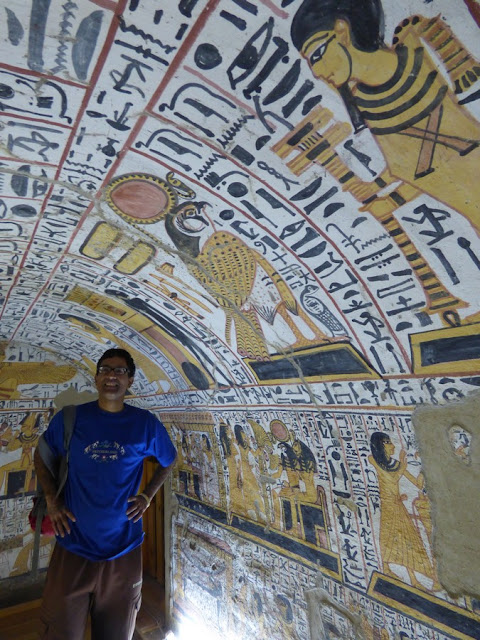




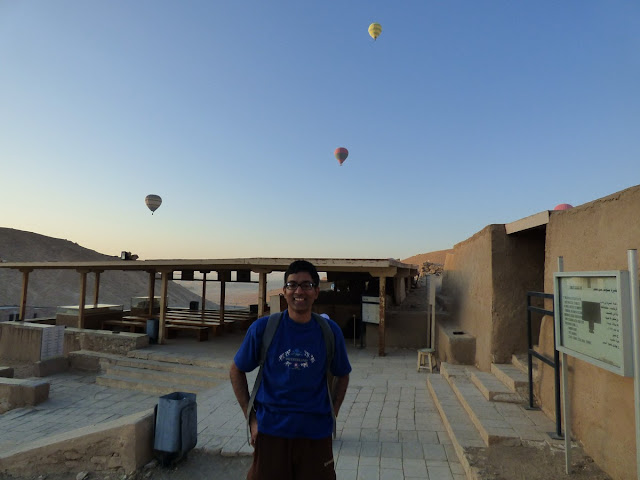









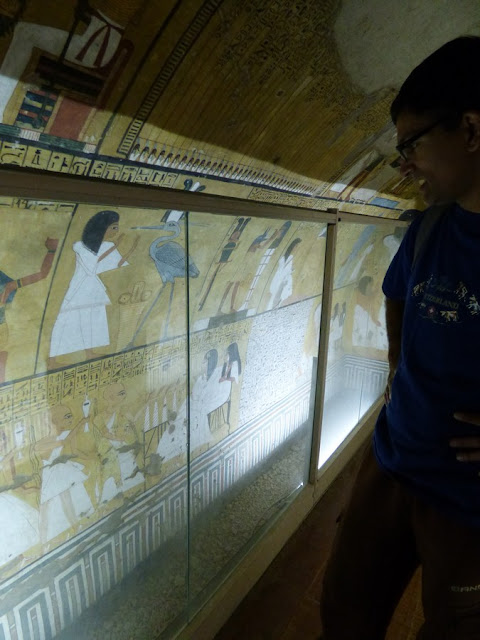

















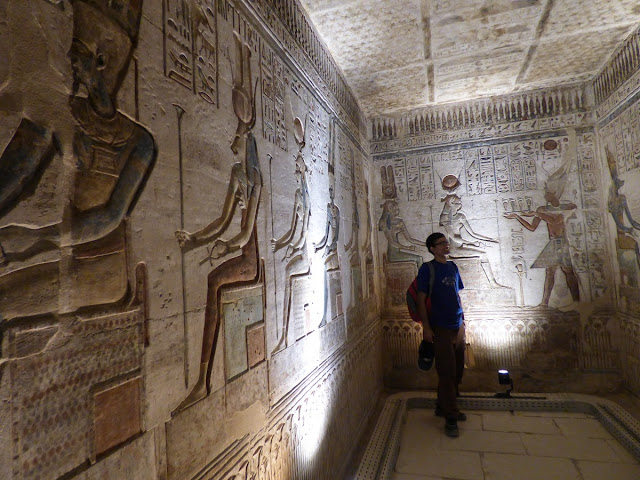
















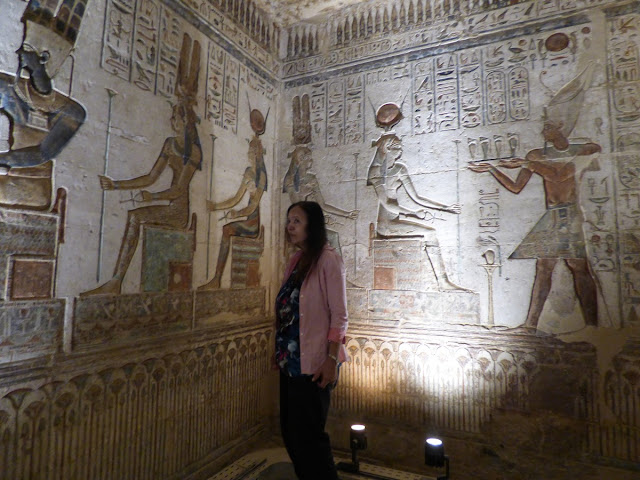












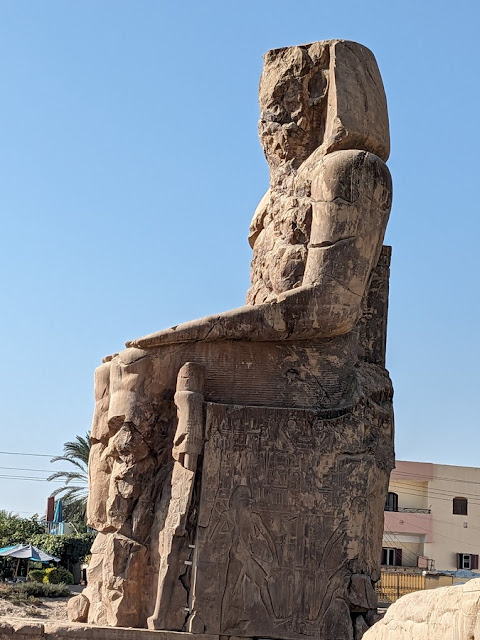

No comments:
Post a Comment